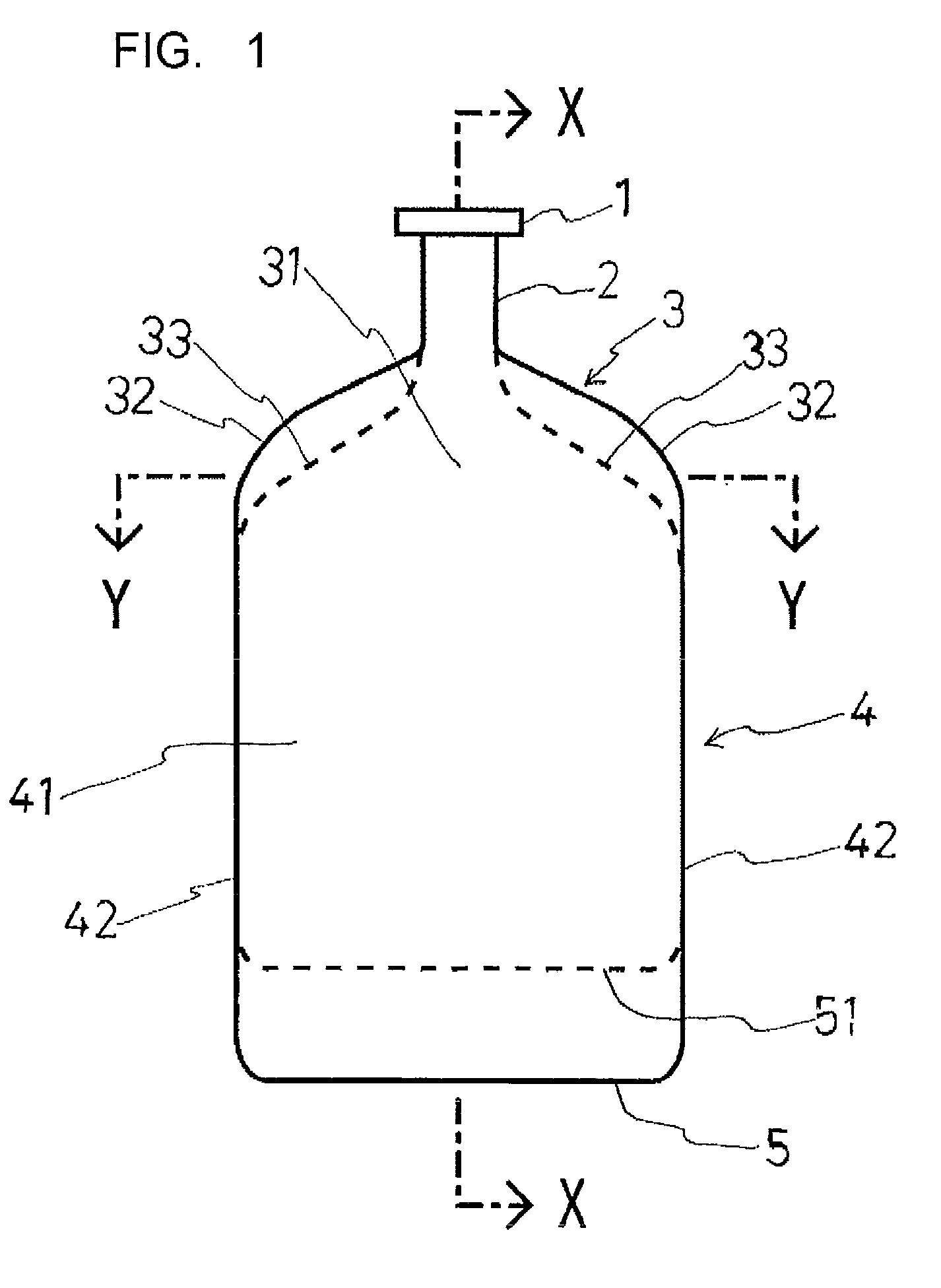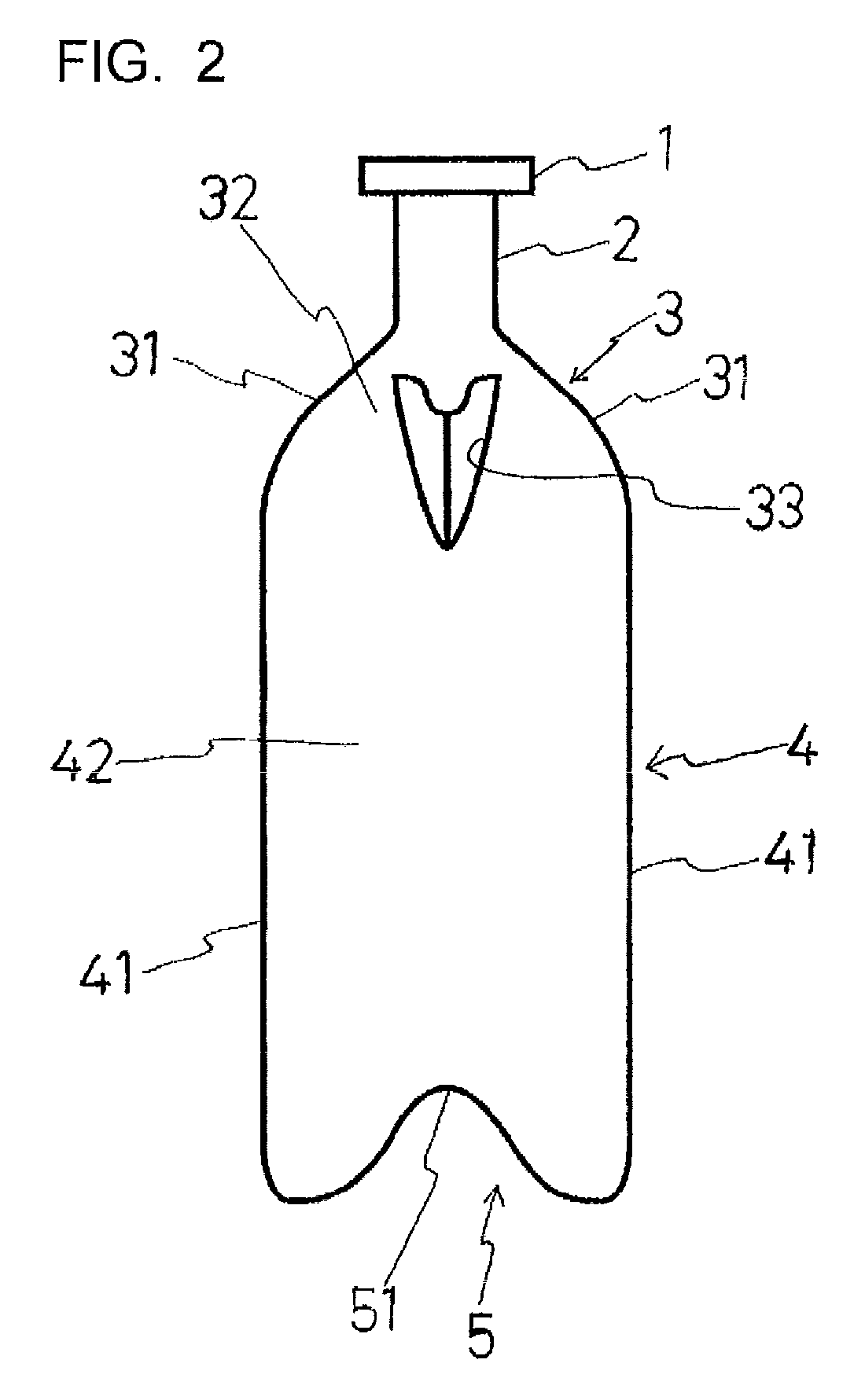Blow-molded plastic infusion container
a plastic infusion container and blow molding technology, which is applied in the direction of containers preventing decay, packaging foodstuffs, and packaged goods, etc., can solve the problems of inflexibility, excessive amount of drug solution to remain in the container, and the method of insertion of air needles into the rubber stopper of the container has a disadvantage for working, so as to reduce the amount of residual liquid, easy to fold, and easy to fold
- Summary
- Abstract
- Description
- Claims
- Application Information
AI Technical Summary
Benefits of technology
Problems solved by technology
Method used
Image
Examples
example 1
[0075]Firstly, example 1 of the present invention will be explained with reference to FIG. 1 to FIG. 5.
[0076]FIG. 1 is a front view of an infusion container illustrating example 1 of the present invention; FIG. 2 is a side view of the container shown in FIG. 1; FIG. 3 is a plan view of the container shown in FIG. 1; FIG. 4 is a cross-section view of the container taken along the line X-X in FIG. 1; FIG. 5 is a cross-section view of the container taken along the line Y-Y in FIG. 1.
[0077]As shown in FIGS. 1-5, the infusion container of example 1 is a blow-molded container having a mouth 1, a neck 2, a shoulder 3, a barrel 4 and a bottom 5. The barrel 4 has a pair of wide sidewalls 41, 41 and a pair of narrow sidewalls 42, 42. The bottom 5 is formed into a V-shape bent inwardly and symmetrically with respect to the long axis of the bottom. The shoulder 3 also has a pair of wide sidewalls 31, 31 and a pair of narrow sidewalls 32, 32, of which the narrow sidewalls 32, 32 are respectively...
example 2
[0081]Secondly, the present invention will be explained on example 2 with reference to FIG. 6 to FIG. 10.
[0082]FIG. 6 is a front view of an infusion container according to example 2 of the present invention; FIG. 7 is a side view of the container shown in FIG. 6; FIG. 8 is a plan view of the container shown in FIG. 6; FIG. 9 is a cross-section view of the container along the line X-X in FIG. 6; and FIG. 10 is a cross-section view of the container along the line Y-Y in FIG. 6.
[0083]As shown in FIGS. 6-10, the infusion container of example 2 is a container having a mouth 1, a neck 2, a shoulder 3, a barrel 4 and a bottom 5. The barrel 4 has a pair of wide sidewalls 41, 41 and a pair of narrow sidewalls 42, 42. The bottom 5 is formed into a V-shape which is bent inwardly and symmetrically with respect to the long axis of the bottom 5. Also, the shoulder 3 has a pair of wide sidewalls 31, 31 and a pair of narrow sidewalls 32, 32, among which the narrow sidewalls 32, 32 of the shoulder 3...
experiment 6
[0097]In example 5, the containers were formed into a configuration shown in FIGS. 17 and 18 and having a weight of 14.7 g and a capacity increased by 50 mL compared to the container of example 5. For each of the containers, a residual volume was measured in the same manner as in example 5 before and after sterilization. Results are shown in Table 3. The bottles of example 6 showed good results since the container even after being sterilized has the residual volume of 22 mL which is not more than half of the bottle of comparative example 1.
PUM
 Login to View More
Login to View More Abstract
Description
Claims
Application Information
 Login to View More
Login to View More - R&D
- Intellectual Property
- Life Sciences
- Materials
- Tech Scout
- Unparalleled Data Quality
- Higher Quality Content
- 60% Fewer Hallucinations
Browse by: Latest US Patents, China's latest patents, Technical Efficacy Thesaurus, Application Domain, Technology Topic, Popular Technical Reports.
© 2025 PatSnap. All rights reserved.Legal|Privacy policy|Modern Slavery Act Transparency Statement|Sitemap|About US| Contact US: help@patsnap.com



